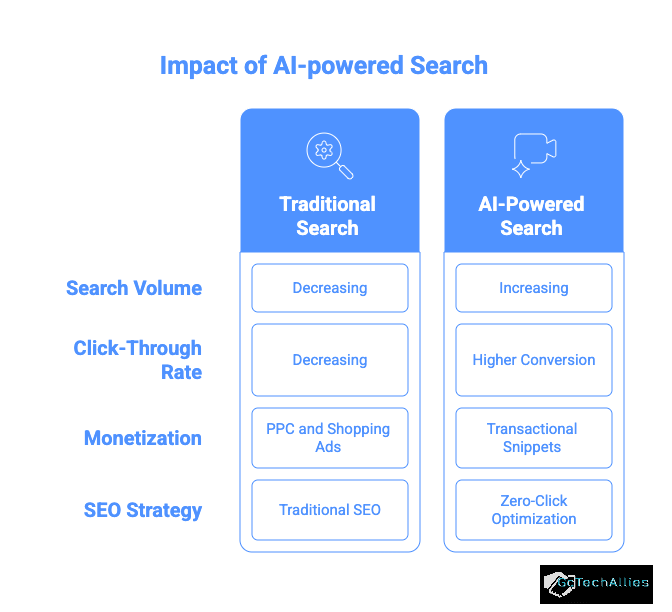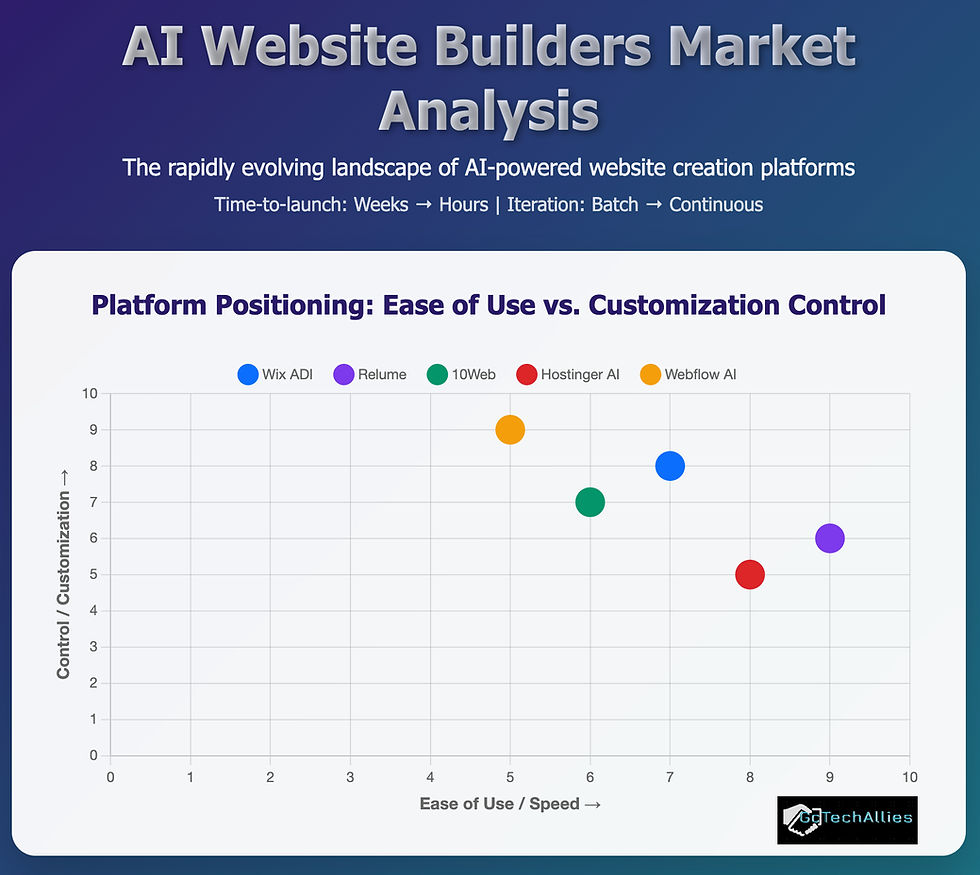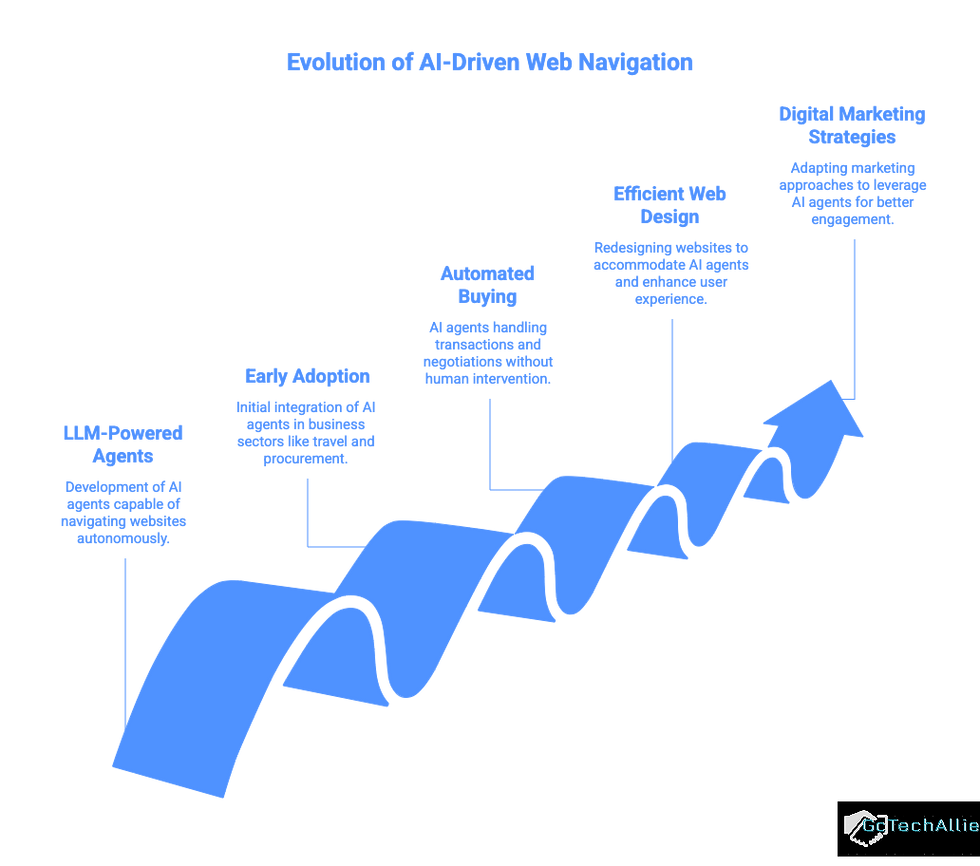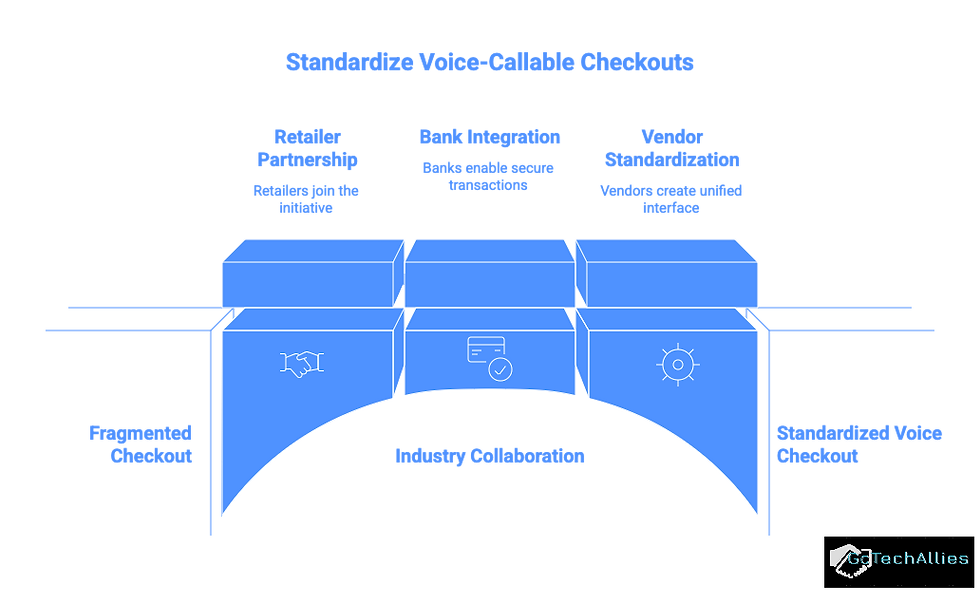Domains in the Age of AI Agents and AI Website Builders: Reshaping Your Web Presence
- Gianluca Luke Caccamo

- Sep 12
- 8 min read
Updated: Sep 15
Over the past two decades a custom domain and multipage website were the default digital storefront. Generative-AI (GenAI) is forcing a rethink. Conversational answer engines, AI-built sites, and domain-name shifts are already reshaping how brands are discovered, trusted, and transacted. The following deep-dive explores how, why, and how fast that change will unfold, and what it means for business strategy between now and 2030.
Youtube Video
Table of Contents
Website Fundamentals
Five GenAI Forces Redefining “Web Presence”
Domain-Name Trends
Implications for Marketing, IT, and Legal Teams
Strategic Partnerships to Look Out in This Space
Concluding Vision
Website Fundamentals
Traditional websites solved four core needs:
Discovery: Search engine indices relied on HTML pages and links.
Trust: A branded top-level domain (TLD) signalled authenticity.
Conversion: Pages funnelled visitors toward forms, carts, or calls.
Data: Analytics cookies captured behavior for remarketing.
These mechanics rested on human navigation—menus, scrolling, clicks—and a browser-based customer journey.
5 GenAI Forces Redefining “Web Presence”
Generative AI is not replacing the web — it’s reshaping how people find, interact with, and trust digital identities. The companies that thrive will be those that understand these shifts and adapt their strategies accordingly.
Five generative AI forces are redefining what it means to have a web presence — forces that are turning static sites into adaptive ecosystems, search into dialogue, and brand presence into something more fluid, intelligent, and personal than ever before. Let's dig in.
AI Answer Engines
Overview: Large language model (LLM) engines and AI-generated summaries at the top of search results answer user queries directly, reducing the need for website clicks. Google and competitors are rolling out “AI Overviews” as their flagship feature.
Market Impact: By 2026, a projected 25% drop in traditional search volume is expected as users turn to these answer engines. Click-through rates decrease by half when an AI overview is shown.
Conversion Trends: While search traffic volume declines for websites, AI search visitors reportedly convert at a higher rate—because LLM answers often provide purchase-ready information.
Monetization Shift: The rise of “transactional snippets” allows users to book or buy directly within search results, spurring growth in PPC ad blocks and shopping carousels on SERPs.
SEO Adaptation: Marketers need to adapt strategies to compete for “zero-click” results, focusing on structured data, conversational content, and paid placements.

Embedded Chatbots
Market Size: The AI chatbot market is valued at $10–15 billion in 2025 and is set to reach almost $47 billion by 2029, with a CAGR of 24–30%. Omnichannel bots for web, chat, and messaging are gaining traction for customer support and sales.
Adoption & Use Cases: Over 465,000 sites run Zoho SalesIQ bots, and B2B leads use bots more than B2C (58% vs 42% adoption). Real estate, retail, finance, and healthcare sectors lead adoption.
Unified Brand Copilots: Enterprises are deploying branded “copilots” across website, chat, and voice touchpoints, leveraging shared memory for smoother customer journeys.
Personalization: Real-time and hyper-personal AI chat interactions are now crucial for retention and upsell, moving navigation from menus to natural dialogue.

AI Website Builders
The market is growing quickly — multiple market reports project multi-billion dollar expansion over the next decade — and incumbent website platforms plus AI-first startups are racing to add capabilities that make a one-minute, publish-ready site the default for small businesses and new projects.
Market Value: The global AI-powered website builder market is valued at $3.17 billion in 2023, and forecasts indicate it will exceed $31.5 billion by 2033, growing at 25.8% CAGR.
Key Trends:
No-Code Accessibility: 70% of new enterprise apps will use no-code/low-code platforms by 2025, up from 25% in 2020. These tools democratize web creation—cutting dev costs by up to 90% and slashing build times from weeks to hours.
Personalization & Automation: AI platforms offer layouts and copy tailored per visitor in real time. SMBs especially benefit from automated, cost-effective solutions for their digital presence.
Growth Factors: Rising digital transformation, a shortage of skilled developers, and SMB demand for online presence are accelerating adoption.
Regional Leadership: North America dominates with a 40.5% market share, but emerging markets in Asia and Africa are driving rapid growth.

Voice & Multimodal Search
User Adoption: Over 125 million annual voice-search users in 2023. Smart speakers are in 75% of households by 2025, and 56% of smartphone users rely on voice queries for brands and businesses.
Accuracy & Satisfaction: Assistants provide 93% accurate responses; 93% of users are satisfied with their experiences.
Multimodal Surge: Visual search has increased by 65% year-over-year as more users combine camera, voice, and touch queries. Multimodal search is central to shopping, comparison, and information lookup, with a market projected at $42.38 billion by 2034.
Commerce Implications: Increasingly, purchase flows are designed for wearable and screen-optional contexts, making domains central as API endpoints behind the scenes rather than destinations for human browsing.

Agent-Based Browsers
Technology Shift: LLM-powered agents are starting to autonomously navigate websites for tasks like travel bookings and B2B procurement. These agents interface directly with APIs to negotiate price, schedule, and policy, bypassing traditional UIs.
Adoption: Early adoption is concentrated in business verticals (especially travel and procurement platforms), with rapid experimentation and integration underway.
Implications: Human intervention is minimized, reducing friction and enabling more efficient automated buying, with implications for both web design (agent-friendly APIs) and digital marketing strategies.

Domain Name Trends
The global domain name landscape is undergoing a dramatic transformation as traditional extensions face stagnation and new, tech-driven top-level domains (TLDs), especially .AI—experience unprecedented growth and cultural influence.
Explosion of .AI
The .AI extension has emerged as the defining digital badge of the AI industry and technology innovators.
Registrations exploded from just 248,609 in mid-2023 to 572,575 by late 2024 and are projected to surpass 6 million by Q1 2025, an order-of-magnitude leap unique even amid the broader TLD proliferation.
.AI domains “telegraph” relevance, credibility, and industry alignment to investors, talent, customers, and even search algorithms, rapidly becoming the default for AI ventures and startups.
This surge is reflected in the aftermarket: Escrow.com reported $2.1 million in .AI sales in Q4 2023, leaping to $4.5 million just two quarters later. Individual .AI domain sales regularly hit six and even seven figures (e.g., fin.ai at $1M, advice.ai for $80K).
Investors now treat some .AI domains as “digital real estate,” where single-dictionary words or brandable phrases are in especially high demand.
As websites become machine-facing—serving as backends for APIs, chatbots, and agents—the signalling and trust role of domains grows, even if direct user traffic wanes.

ccTLDs: Local Trust Drives Steady Growth
Country code domains (ccTLDs) such as .de, .cn, and .us continue to see modest but consistent growth since they:
Foster trust and signal local relevance; for example, businesses targeting German or Chinese consumers overwhelmingly prefer local ccTLDs.
In some regions—central America, Europe, and Asia—ccTLDs are often essential for market penetration and SEO, with consumer studies showing users are 3x more likely to trust sites with their country’s TLD.
ccTLD registrations reached 140.8 million in early 2025, up 1.8% year-on-year, with standout growth like .cn (+14%) and .de (+12.5%).
Tech Domains (.io, .app, .dev) and Niche TLDs
Other tech-favored extensions, such as .io, .dev, and .app, continue to enjoy growth among SaaS, startup, and developer communities, but are being outpaced by the momentum of .AI.
.io gained just 0.7%, .dev 1.08%, and .app 0.79% recently, versus nearly 8% over short periods for .AI.
Choosing between .io and .ai now depends on whether a company is centered on AI (favoring .AI) or on general tech/startups (favoring .IO), with SEO and credibility implications in their respective fields.
.COM and .NET: Market Maturity and Fatigue
The once-dominant .COM/.NET TLDs now show signs of saturation and mild decline. Registrations fell by 2.1% year-over-year between 2024 and 2025, dropping to a combined 169.8 million by Q1 2025, despite .COM still accounting for more than 150 million domains. This downturn is linked to several factors:
The pool of available, memorable .COM names is shrinking, making it harder for new brands to stand out.
The SEO value of .COMs has waned, as AI-generated snippets and new search paradigms reduce the organic click-through advantage legacy domains once enjoyed.
Diversification into niche and next-generation TLDs is a growing trend, with new gTLD registrations jumping by 13.5–17.4% annually and more businesses seeking industry-specific identities.

Implications for Marketing, IT, and Legal Teams
This section looks at the key strategic implications for cross-functional teams shaping web presence in the next five years, with current market evidence highlighting the importance of of web discoverability, conversion, domain management, and compliance. Let's see each in detail.
Discoverability Playbook
The next wave of discoverability is defined by proactive alignment with generative AI and answer engines, not just legacy SEO. Let's see in more detail what actions should be taken:

Conversion Redesign
User-to-business conversion paths are being rapidly reengineered to meet the expectations of an AI-mediated digital audience:

Domain Portfolio Management
As generative AI elevates the role of domain signals in trust and brand discoverability, legal and IT teams should:

Content & Compliance
Legal, IT and marketing teams must work together to anticipate and handle:

These cross-functional recommendations reflect a market where AI discoverability, agent trust, frictionless conversion, and rigorous compliance are now foundational imperatives. Forward-thinking brands and organizations that systematically address these areas will achieve superior visibility, conversion rates, and regulatory resilience amid the accelerating shift to AI-first web ecosystems

Strategic Partnerships to Look Out in This Space
One of the hardest and most strategic opportunities in AI + commerce: making voice-callable checkouts (i.e., being able to say “buy this” in a conversational interface and have it securely completed) a cross-industry standard. How can retailers and banks partner with conversational commerce vendors to standardize voice-callable checkouts.
1. Sweet spot
Retailers want frictionless checkout to reduce drop-offs in both e-commerce and voice/AI channels.
Banks/payment providers want to be the trusted — preventing fraud while enabling new revenue streams.
Vendors (conversational commerce platforms, LLM-based checkout assistants) need scale and adoption across verticals.

👉 The core challenge: How to make voice checkout as standardized, secure, and interoperable as card-not-present payments are today.
2. Partnership framework
a) Establish a joint standards consortium
Similar to what EMVCo did for chip payments or W3C for web payments.
Retailers (large chains, marketplaces), banks (top issuers/acquirers), and conversational commerce vendors (like OpenAI plugins or Voiceflow) can co-develop:
APIs for voice-to-payment routing
Shared authentication protocols (biometric, tokenized voice signatures)
Fraud monitoring interoperability
b) Create a “trusted voice checkout” certification
Banks and retailers jointly back a label ensuring any conversational commerce flow meets standards (PCI-DSS, PSD2, voice biometrics).
Customers can then trust “this checkout is bank-certified” when talking to an AI agent.
c) Pilot with anchor partnerships
Retailers in grocery, QSR, and fashion (high repeat orders) partner with top banks and 1–2 conversational vendors.
Use real customer pilots (e.g., “Reorder my groceries via voice, pay with my Chase card.”)
Showcase cross-industry interoperability → scalability.
3. Technical building blocks
Voice tokenization — Similar to card tokenization, banks issue “voice tokens” tied to a user + device + payment method.
API gateway for checkout orchestration — Conversational commerce vendors connect into bank APIs (via PSD2/Open Banking in EU, FedNow rails in US, etc.).
Shared authentication rails — Biometrics (voiceprint, device-based faceID) instead of passwords.
✅ Key insight: For this to succeed, banks must own the trust and authentication rails, while retailers and vendors drive customer experience. Without banks, voice checkout will lack credibility; without retailers, it will lack scale; without vendors, it will lack usability.
Concluding Vision
By 2030 the “website” as a multipage brochure will be a backend knowledge base: a structured, authenticated domain that feeds GenAI assistants, voice agents, and augmented-reality overlays. Human visitors will still arrive—especially for rich media storytelling—but most micro-interactions (FAQ, quote, booking, support) will bypass traditional navigation.
Custom domains will not disappear; they will evolve into trust beacons anchoring branded data sets in a sea of AI-mediated answers. Owning the right domains and exposing clean, structured, traceable information will differentiate brands in an era where the page counts less than the payload. Businesses that embrace GenAI as both a distribution channel and a design partner—while doubling-down on domain-rooted authenticity—will turn disruption into compounding advantage over the next five years.
Author
Gianluca Caccamo connects Leaders with Data for Strategic Partnerships, after more than 15 years at companies like Google, Pinterest and Wix among others. Currently advising companies on E-commerce, Advertising, Saas and AI.
Follow us on Linkedin ❤️
Sources
https://searchengineland.com/search-engine-traffic-2026-prediction-437650
https://aims-international.org/aims22/22AProceedings/PDF/A189-Done.pdf
https://virtuemarketresearch.com/report/ai-website-builder-tools-market
https://circleid.com/posts/domain-industry-2025-current-landscape-and-key-market-data
https://nypost.com/2025/07/03/media/google-ai-tools-depressing-traffic-to-news-sites-report/
https://www.linkedin.com/pulse/ai-chatbots-accounted-just-296-search-traffic-2024-study-bw6gc
https://domainnamewire.com/2024/02/19/escrow-com-reports-domain-sales-decline-in-q4-but-ai-strong/
https://www.networksolutions.com/blog/impact-of-voice-search-on-seo/
https://www.linkedin.com/pulse/edition-24-do-businesses-still-need-websites-jacob-cauchi-hy4ye
https://sites.google.com/site/horstwebdesign/google-sites_1/gemini-ai
https://www.newsweek.com/ai-chatbots-could-replace-web-search-1886149
https://workspace.google.com/resources/ai/prompts-for-small-business/
https://www.icrossing.com/insights/will-ai-chatbots-replace-traditional-search-engines
https://belovdigital.agency/blog/the-impact-of-voice-search-on-web-design-and-seo/
https://www.bizway.io/blog/7-creative-chatgpt-prompts-for-website-design-and-user-interface
https://www.webydo.com/businesses-adopting-ai-website-builder-in-2025
https://www.linkedin.com/pulse/ai-website-builder-market-technology-trends-growth-scope-rwjve







Comments